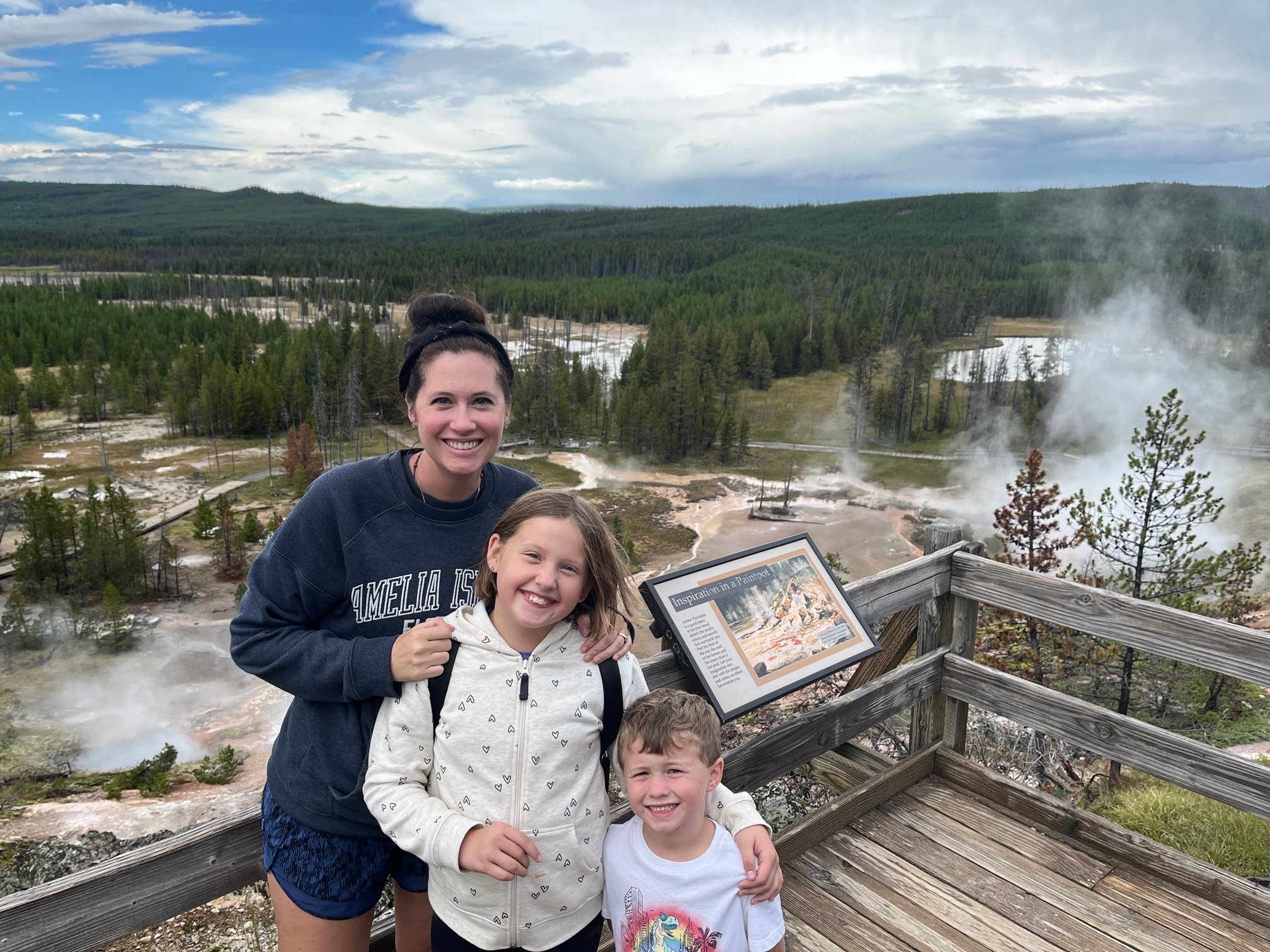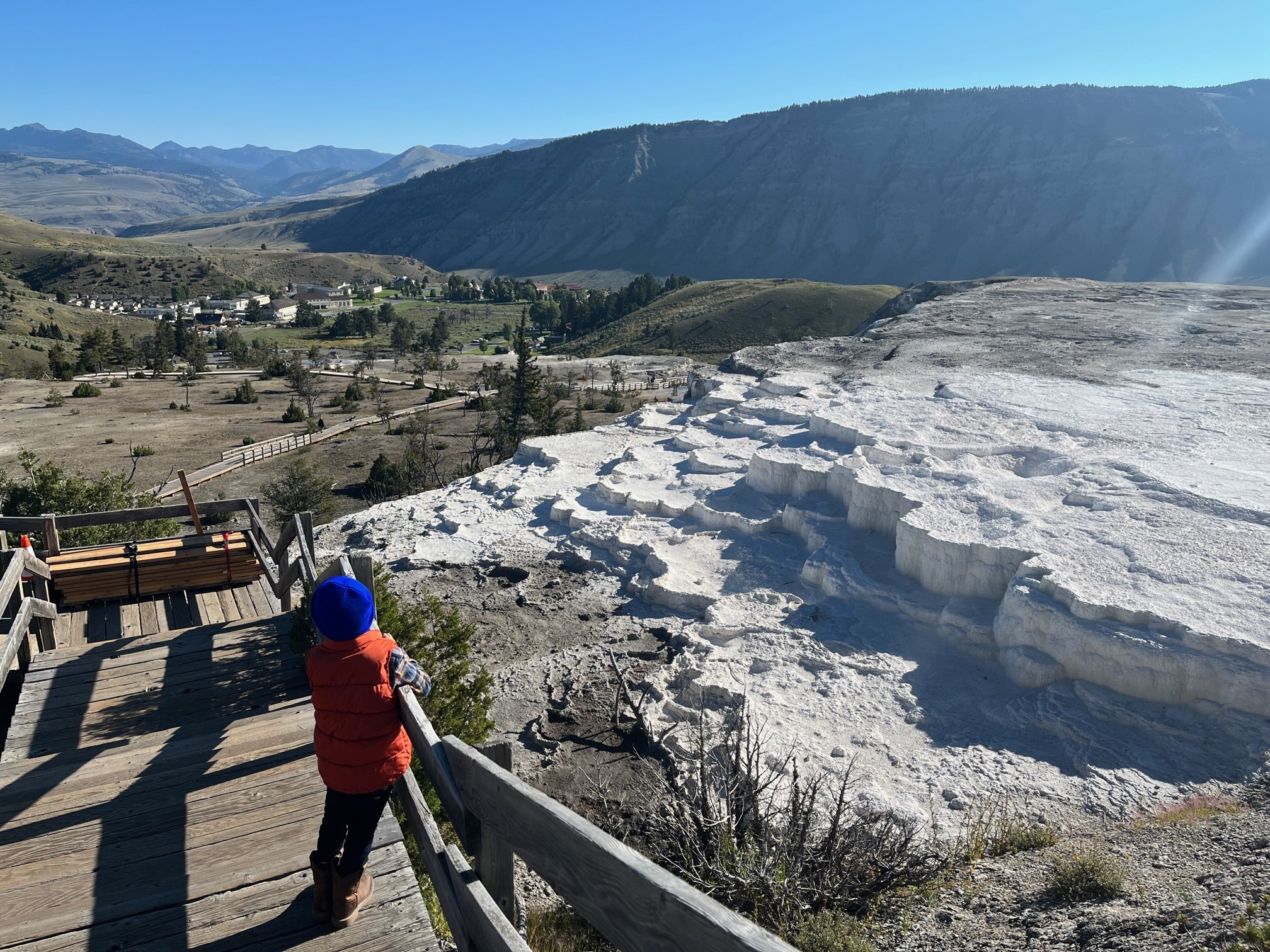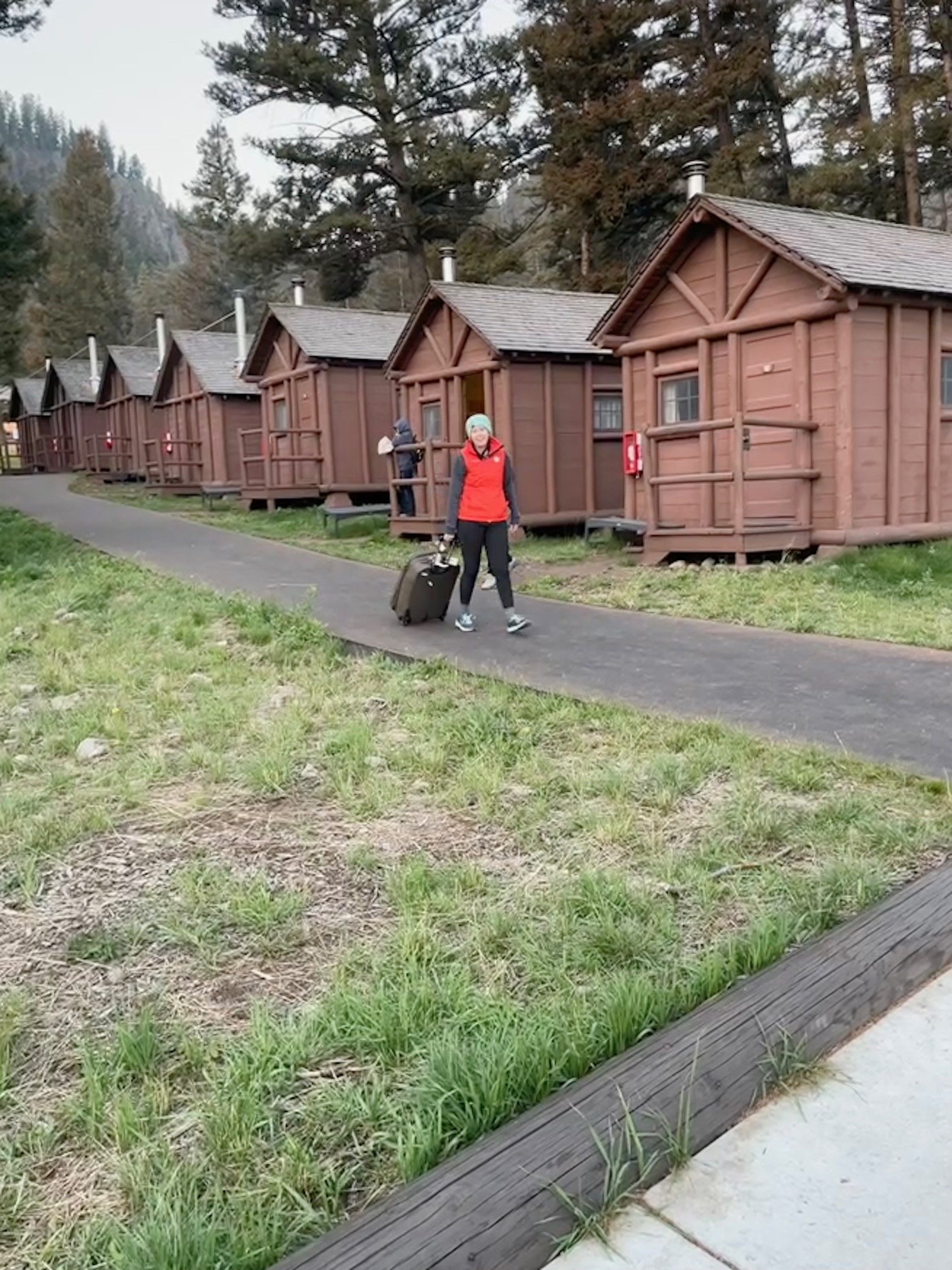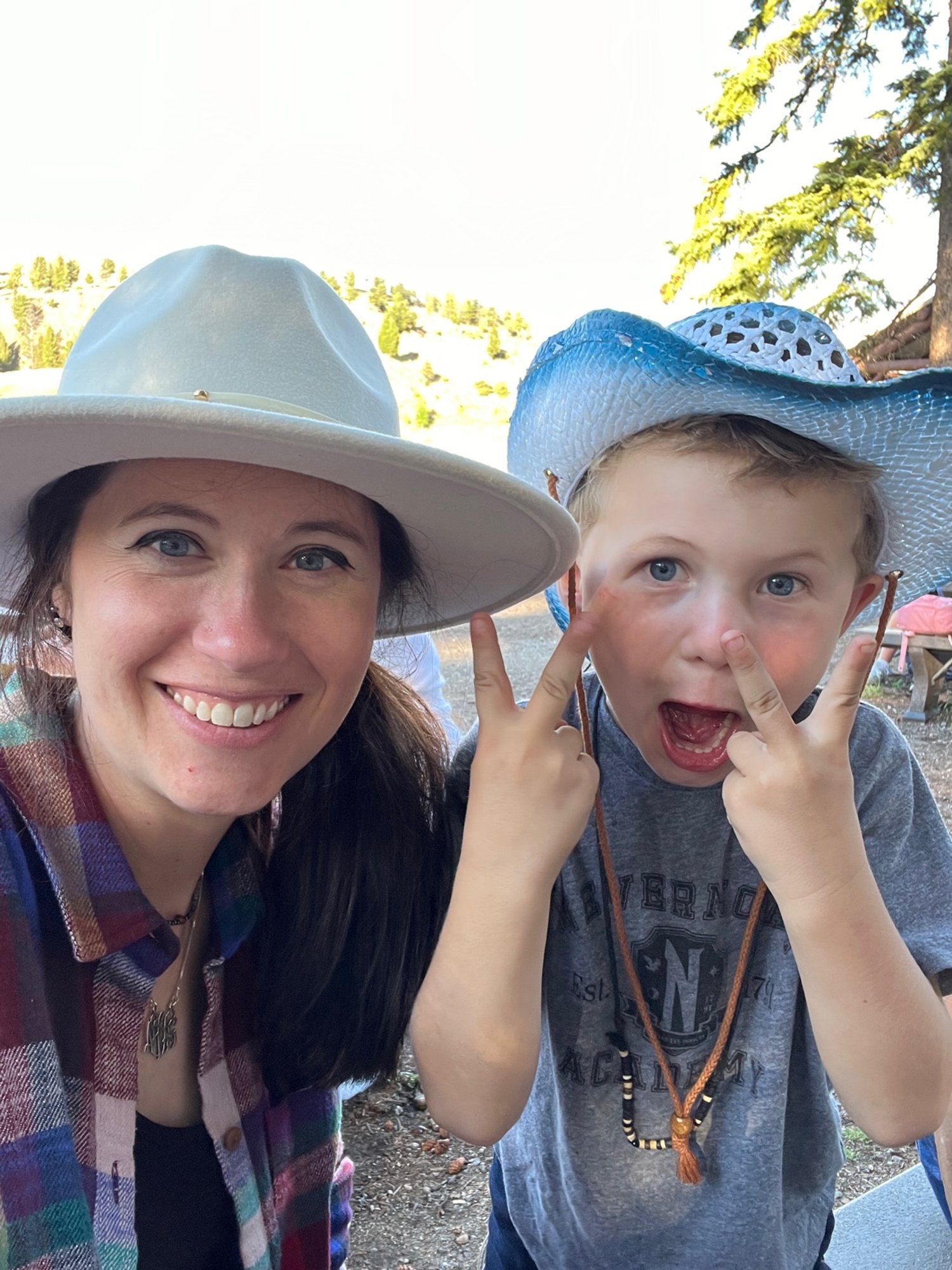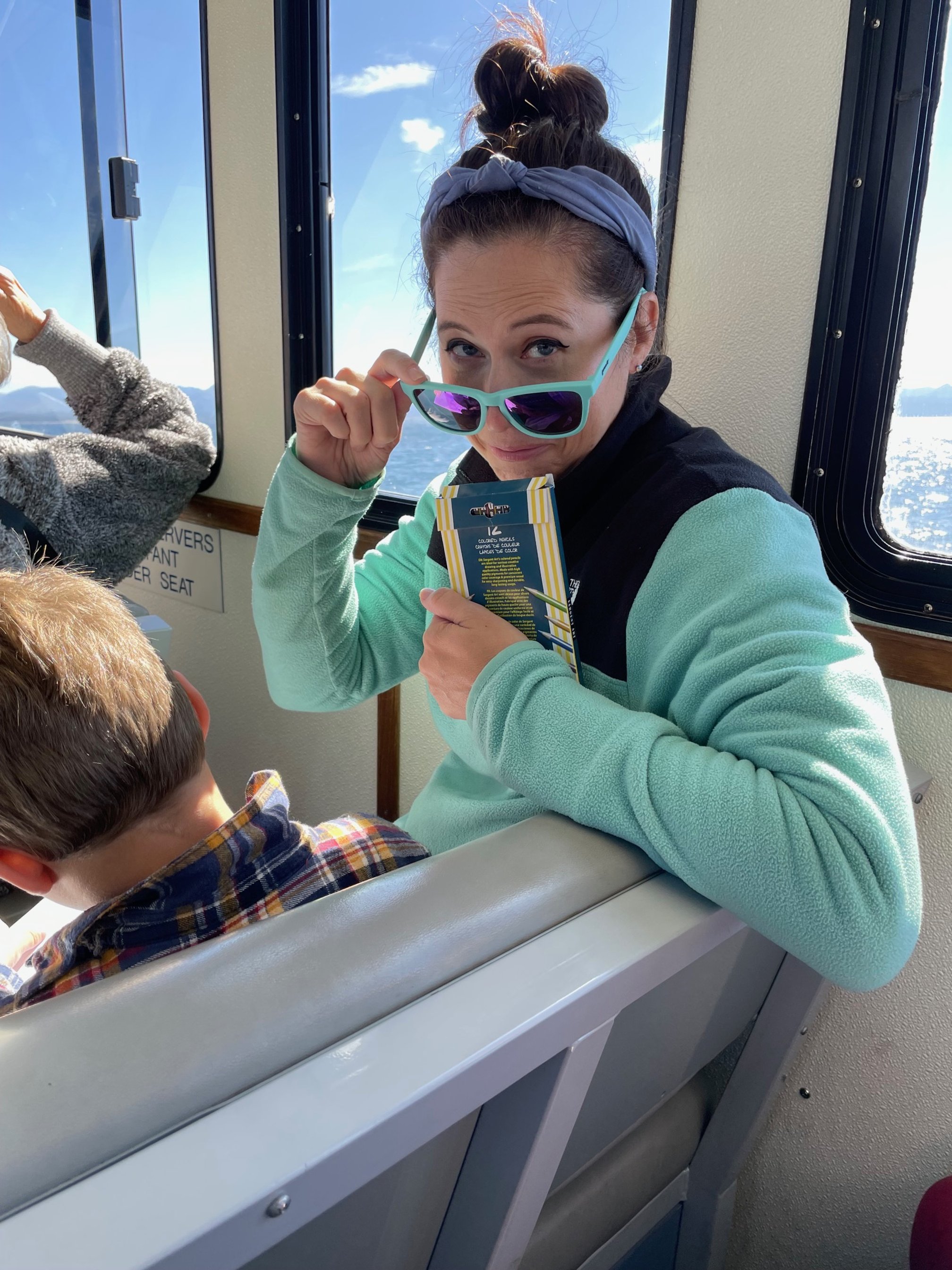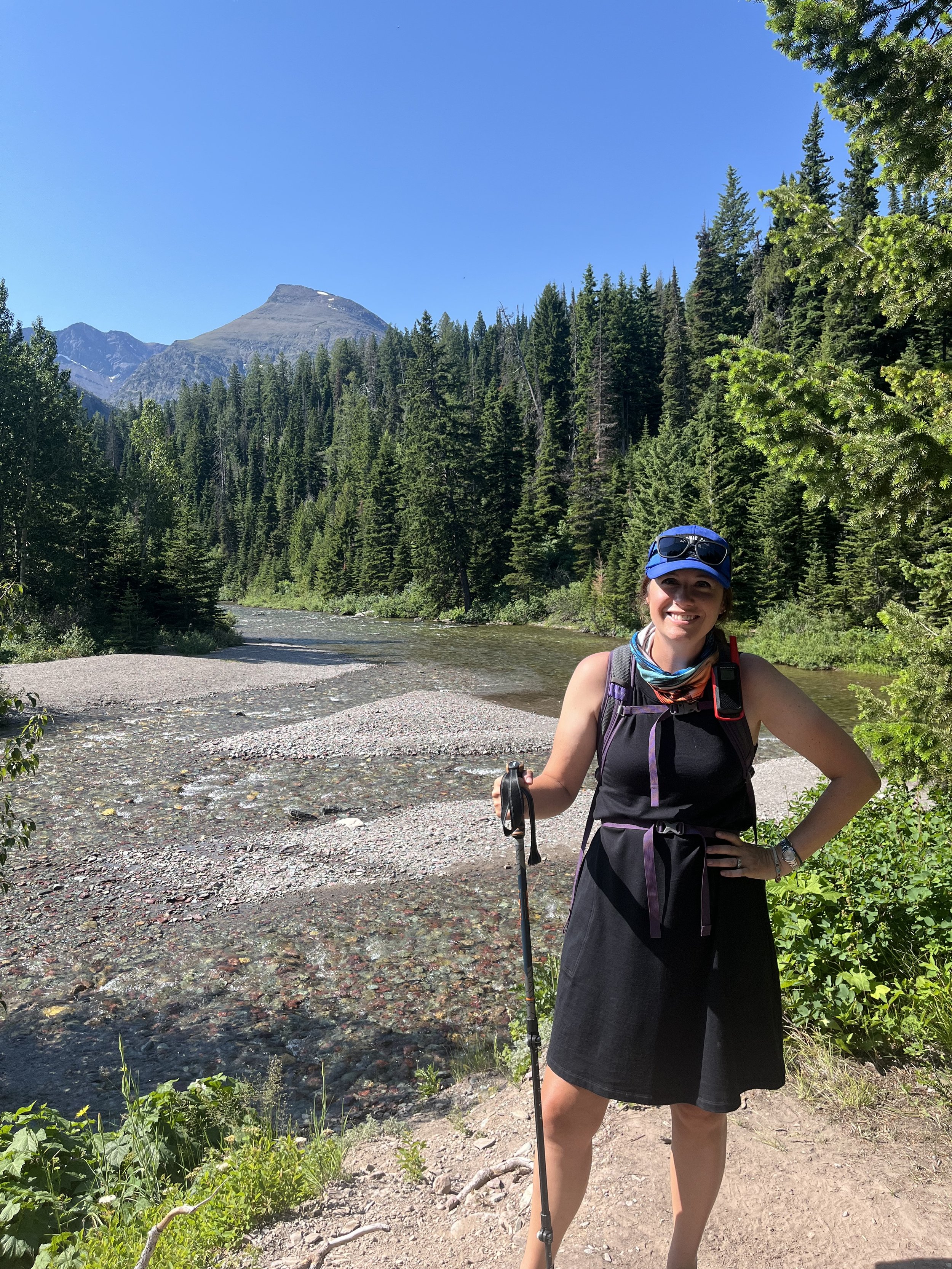Packing List for Yellowstone in August + Printable!
Simplify your Yellowstone packing for an August trip with this comprehensive list and free printable PDF!
The author and her suitcase at the Roosevelt Cabins in Yellowstone National Park
The weather in Wyoming can be highly variable at the end of the summer, so I’ve put together a helpful printable packing list that will help you prepare for any condition.
This summer packing list is heavy on layers, which will take you from any of the trails in Yellowstone to ranger programs at the visitors centers.
I’ve also included suggestions on other helpful items that will make your stays inside the park’s hotels more comfortable, so you’re prepared for every minute of your Yellowstone vacation, morning, noon and night.
Yellowstone National Park is truly a special place that should be on any family’s must-visit list.
I hope that this comprehensive summer packing list and printable make it easier for you to prepare for that once in a lifetime Wyoming vacation!
This post contains affiliates. If you purchase through the links below, I will receive a commission at no charge to you.
Yellowstone Weather in August
The weather in Yellowstone National Park in August is quite mild, in general.
My family is from South Carolina, where the summer temperatures are down right oppressive, so we love to travel to places like Wyoming during the summer months.
Summer days in Yellowstone range from the mid-60s to the mid-70s, while night time temperatures dip into the 30s. (See chart below for more details, laid out monthly.)
That means that you’re going to have to pack clothes that will keep you comfortable despite the 30 and 40 degree differentials between early morning and mid-afternoon.
Average Yellowstone Temperatures
This wide range of temperatures means that some years you’ll have snow in June, and other years, you’ll be able to splash around at the beach near Fishing Bridge.
During our most recent visit in the weeks leading up to Labor Day, we experienced several days that topped out above 80 degrees with clear blue skies, and several other days where the temperatures didn’t get above 50.
We had one rainy night that included a bit of sleet!
So, what does this mean for your packing plans?
You’ll need to watch the weather in the days leading up to the start of your vacation very carefully…and then still plan to bring a wide range of layers.
The weather can—and will—change constantly during the days you’re in the park. You might start the day in a fleece and beanie, and be down to leggings and short sleeves by lunch.
The pictures in this gallery were all taken within 24 hours of one another. So many layers, so little time!
Can I use this list if I plan on just carry-on luggage?
If you’re flying into Wyoming for your Yellowstone experience, that means you’re quite limited on the luggage space you have—and therefore, the number of clothes that you’re able to take with you.
On our most recent trip to Yellowstone (which was in August and September), we flew with carry-ons and a single checked bag.
I hate checking a bag when flying, but it was necessary in this case as I had to take my kids’ school books, an extra sleeping cot, and extra blankets. More on that later.
If you don’t need those items, you could easily get away with this packing list inside a carry-on.
Just remember to wear the bulkiest items onto the plane if you’re having trouble fitting anything.
This might mean that you’re wearing a jacket in 90 degree weather when you board the flight in Charleston, but you won’t have to pay for luggage charges! (I’m nothing if not frugal.)
What to Pack for a Yellowstone Summer Vacation
Yellowstone National Park truly has something for every visitor.
For those who like to take in the scenery slowly from their car, you’ll find bison herds in Lamar Valley and Hayden Valley.
For those who like to hit the trails, there are some beautiful, easy hikes in Yellowstone that the entire family can enjoy.
My son and I on the most beautiful summer evening at the Yellowstone Old West Cookout Dinner
For families who want something a unique dining experience, you can saddle up for the Yellowstone Old West cookout dinner and trail ride.
And that’s just the start! There are bubbling mud pits, waterfalls, a canyon, geysers, hot springs, and so much more.
[For more information on what you should see and do, check out my massive Yellowstone Family Vacation Guide.]
Given that you likely want to experience something in each of these categories AND that the temperatures might be anywhere from 40 degrees to 75, your vacation wardrobe needs to be versatile, hardy, and filled with layers.
Below, I’m sharing the key pieces that every person in your party should have available while in Yellowstone.
Keep in mind that I’ve erred on the side of being highly prepared, so you’ll see a wide range of items here. I’ve also assumed that the average person visiting Yellowstone National Park doesn’t enjoy walking in shorts and a light shirt even when the temps are in the mid-50s.
However, that might be my thin Southern blood talking, so feel free to customize this list to suit your specific needs.
NOTE: I’ve also included a downloadable PDF of this packing list below. Simply enter your email address into the box to have it sent directly to your email.
Summer Yellowstone Clothing List
Note: in each section below, I’ve shared specific articles of clothing that have worked for me and my family while visiting Yellowstone National Park.
Whenever possible, I’ve included sizing to help you determine how my favorite brands will fit you. For reference, I’m 5’7” and 135-140 pounds.
These items are generally unisex; we packed essentially this same list for everyone on our most recent trip, from my 7 year old son to my 71 year old dad.
Leggings
One of the key pieces in my capsule women’s hiking wardrobe is a versatile pair of leggings.
The elevation makes a huge difference in temperature! The day we explored Lamar Valley, Cooke City, and the Beartooth Highway required leggings and extra layers.
There are pairs out there for every budget and body type, and I encourage you to try on multiple pairs to see which fit you the best.
My go-to general hiking leggings are the lightweight but super comfy Ultra High Rise Elation Tight from Athleta.
These are long enough for my 5’7” frame, breathable for warmer temperatures, and protective from any low branches on the trail.
The only thing I don’t like about them is that they don’t have pockets, which I sometimes miss when I want a quick place to stash my phone.
The Athleta tights are also pretty expensive, though I’ve had mine for 3 years, and they’ve held up beautifully.
If you’re colder natured like I am, you should consider taking a pair of fleece lined leggings to Yellowstone, too.
My mom took a pair of the Ewedoo Fleece Lined leggings she bought on Amazon, and she was comfortable throughout our trip.
I immediately asked for a similar pair for Christmas, and I really wish I’d had a pair for our late summer Yellowstone trip. Those early mornings and chillier days call for something thicker than my go-to Athleta leggings, and the fleece leggings are a good choice.
I wear a medium in the linked fleece lined leggings above, which fit well.
Shorts
In my favorite Athleta shorts at Grand Prismatic Springs in Yellowstone
With the crazy temperature changes that are possible in Yellowstone in summer, you’ll want at least 1 or 2 pairs of lightweight shorts in your suitcase, too.
On those days when the highs are in the upper 70s and lower 80s, shorts are a great option for hiking on one of the many easy trails in Yellowstone and beyond.
I love my Athleta High Rise Mesh Racer shorts, and I have 5 pairs of them in 2 different patterns. (I’m one of those people who buys something I love over and over again!)
If you can grab these during one of Athleta’s sales, they’re pretty reasonable.
However, if you’re shopping on a budget, the Gym People High Waisted Running Short is nearly a perfect dupe.
Hiking Pants
For those Yellowstone visitors who don’t want to wear leggings—or who want to add another layer to those leggings on colder days—hiking pants are an essential part of your national parks wardrobe.
I love my black and orange pair from REI x Outdoor Voices, which have tons of pockets. They’re also loose enough for me to layer my leggings or base layers underneath them.
This is another area where I’d encourage you to try on many different pairs to see which features you’d like. Hiking pants come in so many styles from tighter fitting straight legged pants to flowy jogger style pants.
Fleece Jacket
Another perfect layer for those early morning walks by Lake Yellowstone or an evening ranger program, a fleece jacket is essential.
You can pile a good fleece jacket onto one of your essential t-shirts, and stay comfortable throughout everything you do at Yellowstone National Park.
In my North Face fleece while getting a tour of Lake Yellowstone
I have a color blocked North Face fleece that I bought about 2 years ago, and it is a camping staple for me.
It’s also held up really well, despite being used constantly.
One of my souvenirs from Yellowstone was a branded Columbia fleece tunic which was quickly become one of my favorite outdoor clothing options.
That longer fleece tunic with my fleece lined leggings means the ultimate in coziness on a chilly morning!
This Columbia tunic is the same thing that I have minus the Yellowstone branding. It comes highly recommended!
Windbreaker
PIN ME!
While I love a good fleece, a strong wind will go right through it—and that’s where a packable windbreaker comes in handy at Yellowstone.
As I’ve mentioned earlier in this post, the weather changes constantly in Yellowstone, and even more so if you’re moving to different areas of the park over multiple days.
It’s not at all unusual to have a quick rain shower come out of nowhere as it did for us while we were exploring near Old Faithful.
Luckily, with a combination of waterproof windbreakers and some quick darting to a nearby hotel, we were able to stay dry until the storm passed.
The Columbia Flash Forward Windbreaker is water resistant, comes in a bunch of cute colors, and packs down to nearly nothing.
Keep one of these in your day pack at all times, and you’re ready for whatever the crazy Wyoming weather throws at you.
Long Sleeved Shirts
We could debate the pros and cons of wool vs. synthetic outdoor gear here, but instead, I’ll encourage you to pack whatever long sleeved shirts are comfortable.
Not everyone experiences Yellowstone National Park in the same way, and that’s okay!
If you plan to do nothing but hike, go on trail rides, and other outdoor activities, you might want to invest in a few solid wool pieces.
Otherwise, a couple of your favorite t-shirts with long sleeves will work just fine here.
I took a long sleeved button down flannel from L.L. Bean, and a couple of old favorite cotton long sleeved tees, which I layered under my flannel shirt and even the fleece on colder mornings.
Short Sleeved Shirts
Similarly to the long sleeved shirt section above, pack what makes sense for you and your chosen activities.
I packed a combination of my more expensive wool t-shirts with a few favorite cotton and synthetic shirts, which worked just fine for our wide array of activities.
Whatever you pack, make sure they’re comfortable and can layer with your other long sleeved and outerwear options.
Wool Socks
For the longest time, I bought whatever socks were cheapest.
And my feet froze and/or got sweaty whenever we went out hiking.
Until I discovered wool socks, and my life changed forever.
Now, I only own 4 pairs of socks, but they’re all wool.
In particular, they’re Darn Tough socks, which are the best socks you will ever buy. (Bold statement, I know, but I love these things.)
The bottoms of these socks are slightly cushioned, which makes them even more comfortable.
They also manage to keep my feet at the perfect temperature without sweating no matter how far I’m hiking in them.
Do yourself a favor and take these to Yellowstone—and literally everywhere.
Hiking Shoes
My hiking shoes take on the West Thumb geyser basin
If you plan on doing any hiking while at Yellowstone, you’re going to want to upgrade from your tennis shoes, Crocs, or flip flops.
Even some of the easier hikes at Yellowstone, like the Grand Prismatic Overlook trail or Artist’s Paint Pots trail, have bunches of roots, elevation changes, and rocky areas.
Keep those feet happy with a pair of properly fitting hiking shoes or boots. Trying them on at a place like REI or your local outdoor outfitters can help you narrow down the types of shoes that work best with your foot shape.
(But always check online before buying, as the exact same shoe is often cheaper online.)
You’ll need to determine if you like a higher hiking boot, a mid-height boot, or a trail running shoe.
I don’t like having shoes that touch my ankles, so I’ve always preferred a trail running shoe. The Altra TIMP 4 trail running shoe is my favorite hiking shoe ever, and I’m on my 2nd iteration of this same style.
Beanie and Scarf
Layer up with some cold weather accessories at Yellowstone.
A good beanie and/or scarf can get you through those cold rain storms and then allow you to quickly adjust as the sun comes back out again.
I love the CC women’s beanie with ponytail hole since I often have my hair up in a bun or ponytail. I also have the same beanie without the ponytail hole for colder days when I like the extra warmth of my hair being down.
This is another category where you should go with what you already have and what you’re comfortable with.
Baseball Hat
Who doesn’t love a good baseball hat?
This is another outdoor staple around here as we always have a baseball hat or two in our luggage.
It’s great for keeping the sun out of our eyes, while providing a bit of warmth on those days when it might be a little cloudy (but not quite cold enough for a beanie).
Pajamas
The accommodations at Yellowstone National Park come in many different forms: there are spacious hotel rooms at Canyon Village, camping spots at Fishing Village, and the Roosevelt Cabins in Tower-Roosevelt.
Whether you’re running to the bath house at one of the campgrounds or going down the hall to grab some ice in one of the hotels, you’ll want a pair of cozy pjs in your suitcase.
None of the hotels have air conditioning, which means you’ll need to leave your windows open at night to have some cool air circulating.
Knowing that we had a pair of long pajamas meant that I could rest easy since my kids and I would stay warm all night even though that cold air was moving around.
Daypack
My Osprey Skimmer pack and I at Old Faithful
I don’t go on any adventures without a good daypack.
When we’re on road trips and hikes, I don’t bother with a purse—I just haul around a daypack instead. This keeps my overall luggage footprint down while helping me streamline my process in getting my family out of the door.
I have 2 different day packs, a 28L Osprey Skimmer pack and an 18L Osprey Daylight.
I use the bigger one when I know I’m going to be out on the trail for longer periods of time with my kids and/or the weather is going to be all over the place. In those cases, I’ll pack extra food, rain ponchos, and the like, so I need that extra room.
For a shorter hike, I only need somewhere to stash my wallet, phone, compass, whistle, and a few other necessities, so that bigger 28L is too bulky.
I recently added the 18L Osprey Daylight to our gear collection for these shorter and more minimalistic hikes, and it’s worked out really well.
On our most recent trip to Yellowstone, I took the bigger pack, but I could’ve easily gotten away with the smaller one since we exclusively did shorter day hikes.
Regardless of the capacity, you will need a day pack. Yellowstone National Park doesn’t have a lot of activities that allow you to sit on the sidelines, so you’ll be walking, hiking, exploring, and photographing nearly every minute of your visit.
A good day pack will make those activities—and the transitions between them—easier for you, so you can focus on the fun and not be worried if you have everything you need.
Optional Items to Pack for Yellowstone
Sleeping Cot and Bedding
The hotel rooms come with a standard 2 queen beds or 1 king bed.
My kids aren’t huge fans of sharing a bed, and I’m too cheap to buy them their own hotel room yet. (Plus, at 10 and 7, I don’t want to leave them alone for too long lest a brawl break out.)
We’ve found an easy way around this problem: an ultra lightweight cot that we can also use for backpacking.
The Sutekus portable camping cot is easy to put together and lightweight enough that it fit inside my son’s carry-on luggage.
Some of the hotel rooms at Yellowstone had small beds (Grant Village, I’m looking at you), so it was great to have an extra sleeping space for one of the kids.
This cot is big enough that I could easily stretch out on it, too. If you’re trying to save some money on the expensive hotels inside Yellowstone by splitting the cost with friends, this cot is a great way to add sleeping space on the down low.
We topped it with the REI Kindercamp sleeping pad, which also rolls down really small for easy travel.
And that’s most of what you’ll get in the Grant Village lodges
Base Layers
If you’re always cold like I am, you might want another layer or two underneath the items already mentioned above.
Even in summertime, Yellowstone National Park temperatures can dip to at or below freeing at night. This makes for some really chilly mornings.
One of our activities was to take a boat tour of Lake Yellowstone, but the day dawned cold and windy. I really needed something to put underneath my hiking pants and leggings, so I added in my base layers.
I know that for many folks, 3 layers even in 30-ish degree weather is overkill, but I hate being cold.
If you think you might be the same way, throw some base layer pants and shirt in with your luggage.
Water bladder
My daypacks both have water bladders that came with them, and they were lifesavers in Yellowstone National Park.
You’re way up there in terms of elevation—anywhere between 7,000 and 11,000 feet within the park’s main areas—so you’re facing dry air and potential elevation sickness.
You’ll want to have clean water within easy reach at all times during your visit. Stay very hydrated throughout to combat elevation sickness and to keep your skin from feeling like you’re turning into a mummy from the inside out.
If you have a day pack but don’t have a water bladder, you can buy one separately. A 2L is likely good for 1 person on a day hike, but do some research based on your water intake and individual needs.
Likewise, I’d suggest packing multiple tubes of Chapstick and a thick body lotion to help combat the effects of high elevation.
Snacks and Drinks
The food at Yellowstone National Park is both expensive and not that great (especially when you consider how much you’re paying for it!).
For example, at the grocery in Canyon Village, you’ll pay nearly $8 for a regular bar of Philadelphia Cream Cheese. Egads. Needless to say, we ate our bagels dry and regretted deeply forgetting to buy cream cheese outside of the park.
We stocked up in Jackson, Wyoming, before heading into Yellowstone and Grand Teton National Parks, and I’d suggest you do the same.
There are a couple of small groceries and convenience stores in the park, but they’re scattered around the 2 park loop roads.
Instead, stop by a grocery store in Jackson or Cody, Wyoming, or Gardiner, Montana. You’ll have a better selection with less sticker shock. Plus, you’ll then be able to stop and have a snack wherever you are in our Yellowstone adventures since you’ll be your own convenience store on wheels.
Likewise, grab any soft drinks, Powerades, Gatorades, juice boxes, or adult beverages before you enter the park.
If you do end up needing to stop for a meal in the park, check out my guide on where to eat in Yellowstone.
Cooler
We went all in on the grocery store purchases before heading into Yellowstone.
Since we’d purchased cold items like lunch meats, cheese sticks, hummus, and the like, we needed a place to keep our food cold.
We purchased a small disposable cooler in Jackson when made the process of eating on the go much easier.
There are a couple of places in the park that sell disposable coolers—the grocery store at Canyon Village being one of them—but, again, they’re more expensive.
If you’re driving into Yellowstone, I’d encourage you to bring your own cooler since you’ll have less waste that way. We flew to Wyoming, so bringing a cooler wasn’t an option.
You can get ice from the hotels or the convenience stores to top up your cooler.
NOTE: some of the hotel rooms in Yellowstone like Grant Village and Canyon Village do have small refrigerators. Others, like the Roosevelt Cabins, do not offer this option, so you’ll absolutely need a cooler to keep your food safe throughout the park.
If you’re also camping while visiting Yellowstone, don’t forget to check out our most forgotten camping items list and download your camping packing list PDF!
Yellowstone National Park Packing FAQs
Will I need to bring bear spray?
Yellowstone National Park is firmly in grizzly bear territory. While attacks are rare, they DO happen with often fatal results.
Don’t take the chance of running into a grizzly unprepared, and always pack a canister of bear spray when heading out on any trail, no matter how short.
Major airlines won’t let you pack bear spray in your suitcase, so if you’re flying to Yellowstone, you’ll need to rent or buy in Wyoming.
If you’re driving in, you can order bear spray online or pick it up in one of Yellowstone’s border towns.
I’ve broken down everything you need to know about renting vs. buying bear spray in Yellowstone here.
What baby items are available in the park?
If you’re bringing a baby or toddler into the park, you don’t need to wait to purchase their items.
You won’t find anything in the park for babies—no formula, diapers, finger snacks, or the like.
Stock up on extra outfits, bottles, formula, diapers, and anything else your baby or toddler might need during his or her visit.
While a few of the hotels might have a travel pack and play available, I always preferred to bring my own.
When our kids were small, we had this diaper bag that expanded to be a temporary sleeping cot. That was amazing.
What can I do about altitude sickness?
My dad and I both got quite sick on our first few days in Yellowstone.
Thankfully, we’d packed a small medicine case with Tylenol and Pepto-Bismol. I highly recommend including a few travel packets of these basic medications in your Yellowstone luggage in case you also have trouble acclimatizing.
Regular doses of both of those medications plus lots of water were essential in getting us back on our feet quickly.
If you’d like to have a temporary solution to help you through your altitude sickness, you can also bring canisters of oxygen. While they won’t fix your altitude sickness, they will help your headache go away for a bit.


